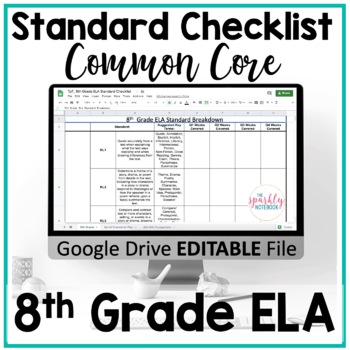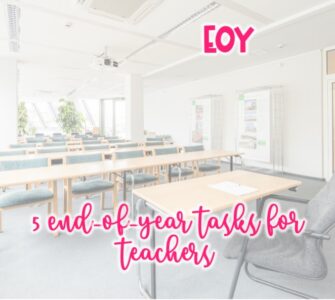A breakdown for teachers who teach W.8 in middle school ELA. In this post, we’ve included learning targets, concept breakdowns, resource suggestions, and activity and assessment ideas!
I have to be honest, W.8 feels like the Goliath of writing standards, and with the overwhelming amount of information students have access to (not all of it credible), it feels even harder to work through this standard with students.
The 8th writing standard is all about gathering information from multiple sources, researching well, and assessing the credibility and accuracy of sources, all while avoiding plagiarism.
That seems like a lot….and it is.
That is why having a good process, including strong learning targets and a good teaching plan, is going to be really important to covering this standard in full.
And THAT is why we’re here today. We want to give you as much information as we can to help make this standard easier to teach. We have complete unit plans available, listed all the learning targets below, and provided some activity and assignment ideas that you can use as you plan how to attack this complicated standard.
Before we begin…
… I want to remind you that we can only do as much as we can do.
A lot of the actual follow-through regarding this standard is going to be up to the students, not cutting corners, thinking outside the box about their research, and making a real attempt not to steal the work of others.
We can teach them how to do it, but with all of these things, they have to make the choice to follow through correctly and ethically.
Don’t beat yourself up if students still choose to cut corners…if they know that is what they are doing, then that choice is on them.
Your job is just to make sure they know how to research, use information, give credit correctly, and explain the consequences of using bad sources, copying others, or not giving credit to others when credit is due. After that, they’re on their own.

As we start talking about how to teach W.8 in middle school, let’s start with the learning targets!
Learning Targets
By focusing on learning targets, we can model our lessons to hit very specific goals and skills. In this post, we discuss how we break down each standard and make a plan for learning, practicing, and reviewing the standards throughout the year using the checklists below.



Here are the learning targets on which we developed our resources for W.8.
Teaching W.7.8 (7th Grade)

7th Grade Standard: Gather relevant information from multiple print and digital sources, using search terms effectively; assess the credibility and accuracy of each source; and quote or paraphrase the data and conclusions of others while avoiding plagiarism and following a standard format for citation
7th Grade Learning Targets
- I can gather relevant information by using effective key terms and analyze the credibility of the sources.
- I can avoid plagiarizing by properly citing my sources and paraphrasing.
- I can incorporate information from a source in my writing in the correct format that flows smoothly.
Teaching W.8.8 (8th Grade)

8th Grade Standard: Gather relevant information from multiple print and digital sources, using search terms effectively; assess the credibility and accuracy of each source; and quote or paraphrase the data and conclusions of others while avoiding plagiarism and following a standard format for citation.
8th Grade Learning Targets
- I can compile relevant information from multiple print and digital sources using search terms effectively.
- I can assess the credibility and accuracy of each source.
- I can quote or paraphrase material from sources while avoiding plagiarism.
- I can use a standard format for citations.
Different Kinds of Citations (room for everyone on this playground)
With internet research becoming the norm, the way we cite is also changing. That being said, there is still a time and place for citations of all kinds.
In our resources for this W.8 standard, we explicitly teach students about MLA formatting. Still, if you have seen our W.7 resources, then you know that we also teach students about hyperlinking when working online.
Students need to know both.
I also know teachers who taught APA and MLA side by side because students were more likely to do their citations correctly when they knew that there was more than one way to cite—learning how to do both helped students become more aware of why the layout was the way it was based on the citation style.
However, there are some people who don’t think there is really a place for knowing how to manually cite at all. They would rather just show students the tools or programs that can cite for them.
I’m not sure I agree with this. In fact, I’ve seen students do better with citations if they actually understand how to lay them out manually.
My recommendation: Don’t drop old-fashioned citations just because they aren’t used as much in contemporary writing.
Citing the old-fashioned way with MLA or APA can also help students identify credible vs. not-credible sources. Citations require students to find dates, authors, and publications, which they might not ever look for at all if they aren’t forced to do it to create a citation.
Resources for teaching W.8
When picking resources to help teach W.8, you’ll want to make sure the resource teaches, practices, and reviews the standard at the appropriate level for the students you’re teaching. The resources below work through the standard using grade-level-specific passages and activities that help the student develop the standard completely.
The resources include a lesson/activity for each specific learning target or concept and also include assessments, posters, and answer keys.
Click on the links below to learn more!
Activities and Projects for Practicing and Assessing W.8 in Middle School
- Keyword Research: Teach students to use research tools to optimize the results they are getting through their online sources. In our resources, we’ve included a handout that goes over several ways you can optimize your keyword research.
- Credible vs. Not-Credible Sources (how to figure out which is which): Take the time to review how to determine if a source is credible or not. Having a handout or checklist students can use as they work with a source can be really helpful. In our 7th grade resource, we’ve included our own “Credible or Not-Credible” checklist for students.
- Plagiarism 101: Your job is to make sure students know what plagiarism is and why it’s a problem. They also need to know how to avoid it. In the plagiarism parts of our 7th and 8th-grade resources, we review what plagiarism is, how to avoid it, and how something as simple as punctuation can cause issues with plagiarism.
Ensuring your students understand and master the standards feels like a huge challenge, and we understand that. That is why we create standards-focused resources that provide teachers with activities, lessons, and assessments that explicitly teach each of the middle school ELA standards.
 End-of-the-Year Tasks for Teachers: 5 Things to Consider Before Leaving the Classroom for the Year
End-of-the-Year Tasks for Teachers: 5 Things to Consider Before Leaving the Classroom for the Year Try these five fun rewards in your ELA classroom
Try these five fun rewards in your ELA classroom 4 Standards-Driven ELA Valentine’s Day Activities
4 Standards-Driven ELA Valentine’s Day Activities